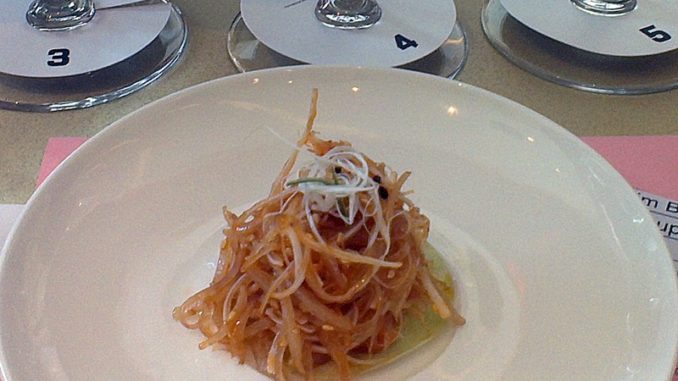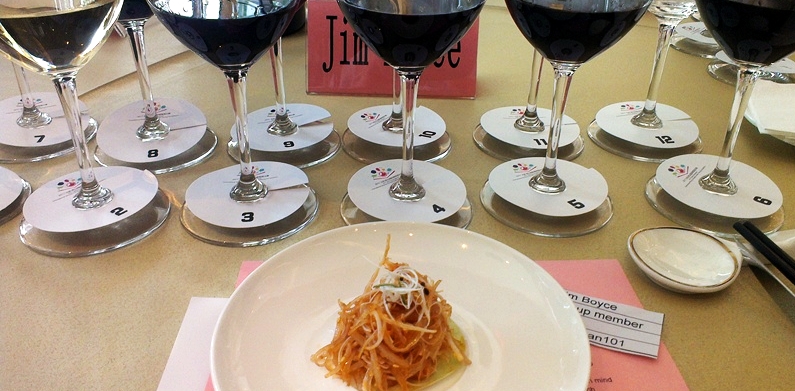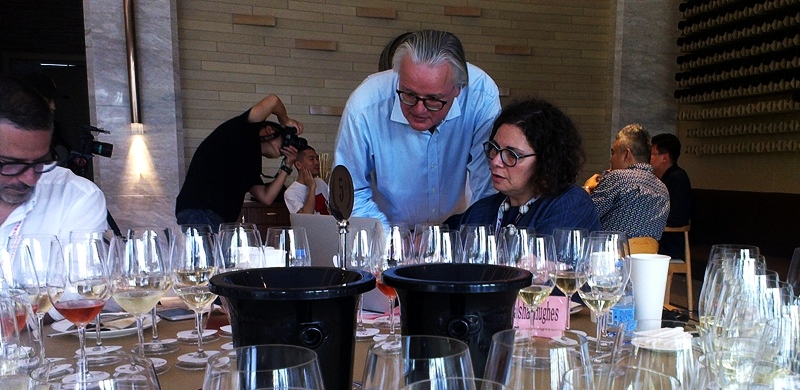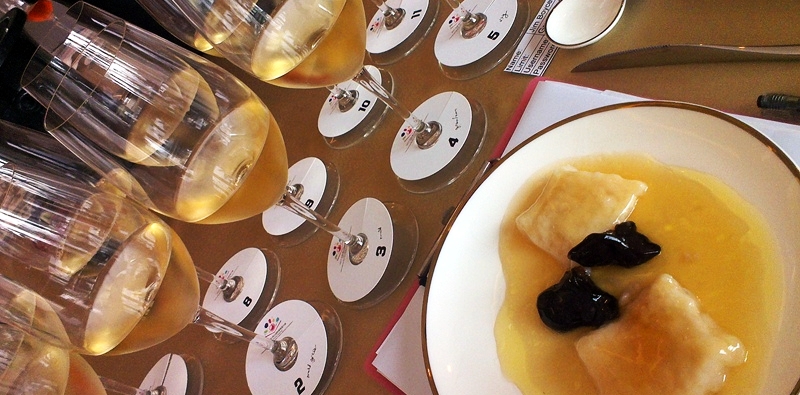
By Jim Boyce | There is trouble at table five.
A group of experts just tried a dozen wines against spicy shredded pig’s ear to pick the best pairing. They’ve already done this dance with steamed fish and with sweet and sour pork. Now two members—veterans from France and Portugal—claim they have the match of the day for that crunchy porcine auditory organ. Wine number 3. They respectively give it 95 and 98 out of 100 points.
Group chair Natasha Hughes, a Master of Wine who (jokingly?) declared that the next person to interrupt her must run three laps around the swimming pool, rains on their parade. Hughes finds the wine dirty and the pairing unsatisfactory.
Uh oh.

This showdown happened at the International Wine & Cuisine Pairing Competition in Beijing’s Fangshan district, organized by S-China Capital with support from Wine 100 and Beijing International Wine and Spirit Exchange. You might wonder why anyone should care about a bunch of experts tasting a bunch of wines against a pig’s ear, a situation few if any consumers will ever face.
I empathize. Such exercises seem overly ambitious given the vast universe of grape varieties, wine brands and vintages. And somewhat irrelevant as the same food and wine can vary dish to dish and bottle to bottle. And it doesn’t help that the trade often sucks more than an air-operated double-diaphragm pump at explaining pairing to those beyond their circles.
But if you have a passion for anything, whether cricket, cameras, cooking or comic book collecting, you might imagine how a wine fan gets excited about what Bordeaux goes best with braised pork belly.
Pairing makes intuitive sense as I tell friends who pooh-pooh the practice but will argue endlessly about the best gin for a martini, the ideal burger toppings or the legitimacy of pineapple on pizza.
At popular hot pot restaurant Haidilao, my friends painstakingly blend dipping sauces from a condiment buffet with dozens of options: spicy chili oil, salty soy sauce, the sweet and sour touches of sugars and vinegars, and more. They are creating the equal of a wine, a magical concoction to match all that emerges from the bubbling broth. So it makes sense some wines will match that broth and those sauces better than others, no?
Anyway, back to table five.

Hughes calls over Andrew Caillard—Australian, fellow Master of Wine, and event co-chair. He tries the wine and declares it faulty. Perhaps in some European events it might get 16 or 16.5 points out of 20, he says dismissively. But in Australia, where screw tops dominate and corks are a minority, it would be a 13.
That sounds harsh to this novice of wine and pig ear pairing.
As Hughes and Caillard discuss the wine further, I ask the French and Portuguese delegates if they plan to change their scores. No way.
I recall our instructions at the start of the day.
“It’s all about the match, not about the wine or the food, it’s about the match,” said Caillard.
Given this, I like the continental European case. The wine and food do pair well, the wine faultiness debatable. Does it matter?
“The panel chair makes the final decision,” Caillard also explained to us earlier. “It’s the final decision, whether you like it or not.”
And so it goes.

To be fair, this was an extreme case. There tended to be more agreement than not with other pairings. But it underscores that even experts can disagree—widely. Two experts gave a pairing of 95 or more points, a score supposed to mean “you’d turn around to someone and say, “If you’re eating this dish, you must find this wine.” Two others found it gross.
That doesn’t make pairing irrelevant, just more complicated in a world where many want simple definitive answers. My advice: consider expert recommendations as just one item in a buffet of opinions, along with tips from friends, suggestions from writers, your own food and drink experience, and more. And if that’s too much, just enjoy the foods you like and the wines you like, and ignore that buffet altogether.
Also, I like pineapple on pizza.

Sign up for the Grape Wall newsletter here. Follow Grape Wall on LinkedIn, Instagram, Facebook and Twitter. And see my sibling sites World Marselan Day, World Baijiu Day and Beijing Boyce. Grape Wall has no advertisers, so if you find the content useful, please help cover the costs via PayPal, WeChat or Alipay. Contact Grape Wall via grapewallofchina (at) gmail.com.
Leave a Reply
You must be logged in to post a comment.